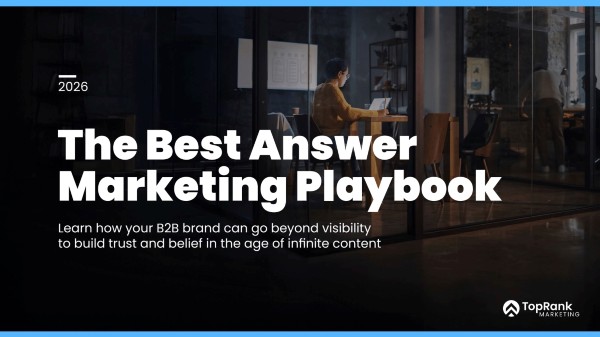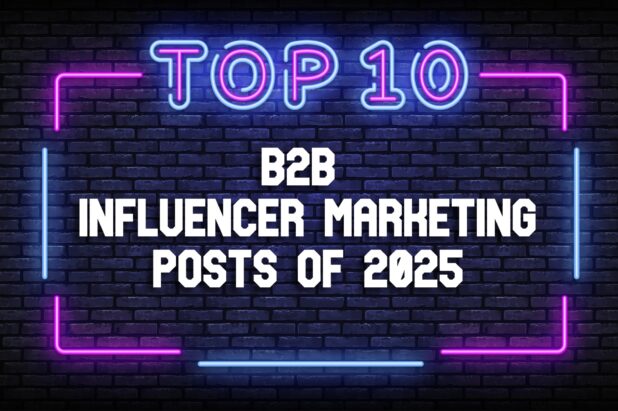In our previous post for the Best Answer Marketing Playbook, we explored how being data-informed vs. simply data-driven helps B2B marketers achieve the kind of clarity they need in an increasingly complicated and changing marketing environment.
Of course data on its own isn’t enough. It’s what you do with those insights that determines whether impact is short tern or something that extends across the customer journey. To help turn data insights into action and impact, the next step in the Best Answer Marketing (BAM) system is building an integrated marketing strategy that aligns thought leadership with brand, demand, and lead generation into a complete system for create impact from awareness to engagement to decision.
Delivering Best Answer experiences requires an integrated strategy
B2B marketers are experiencing a unique confluence of changes making it harder to reach and influence buyers:
- Buying committees are larger, with an average of 11+ stakeholders involved in decisions (Gartner).
- Google AI Overviews decrease CTR by 34.5% (eMarketer/Ahrefs)
- ChatGPT use has increased 70% in 2025 (Sensor Tower)
- Buyers use 10 or more distinct channels to interact with suppliers during the journey. (McKinsey)
- Nearly 75% of B2B buyers say their purchasing cycle has grown longer and more complex (Demand Gen Report).
- 68% of marketers admit they struggle to create content that connects across the entire funnel (Content Marketing Institute).
The buyer information journey as first described in the book Optimize way back in 2012, identifies that in order to attract, engage and convert buyers, B2B brands need to understand how customers are currently discovering, consuming and taking action on information.
Today’s information discovery and consumption preferences are multi-modal going beyond Google and a few social networks. In some cases, we are now experiencing the long tail of search with numerous channels of information discovery to be considered as well as the interplay between customers first discovering solution options through GenAI search like ChatGPT or Perplexity and then validating those findings with Google searches.
Without an integrated approach, B2B marketing teams are at risk of running fragmented campaigns that compete harder for attention and not seeing results, dilute messaging, and fail to tie their contribution back to business outcomes. A data-informed, integrated marketing strategy ensures that clarity of current situation and what is needed to become the best answer and resource on the topics of most relevance to buyers. The strategy that makes an integrated BAM system work aligns thought leadership content, campaigns, and channel efforts to ladders up to a common narrative (Best Answer Topics) and measurable goals that extend from awareness to engagement to conversion.
Data as the foundation of Best Answer Marketing
The data sources we explored in the Data Pillar of BAM: CRM, analytics, SEO, surveys, social, audience, and original research, are some of the options for what can fuel a strong integrated BAM strategy. We have a preference for aligning original research, which is one of the most effective ways to create trusted thought leadership for a brand, with other data sources to inform the more practical aspects of a full funnel campaign. Whether a data source works on its own multiple sources work to validate specific Answer Topic narratives, it helps:
- Align specific B2B marketing goals to sales and revenue outcomes.
- Define the Ideal Customer Profile (ICP) and the questions they need answered.
- Prioritize the narratives and topics that matter most to buyers at each stage of their journey.
- Define current situation of the buyer information journey: discover, consume, decision
- Identify gaps where brand trust, visibility, or influence needs to be built.
With this foundation of data, B2B marketers can move from insight to orchestration of a Best Answer Marketing Strategy. It is this orchestration plan that incorporates the insights needed to deliver highly relevant, trusted, visible, experiential content experiences in the multiple channels where buyers are looking – making your B2B brand the best answer for your customers.
Having the right data and insights is essential for B2B marketers operating with fewer sources and higher expectations. Those expectations are not only from senior business leaders in relation to marketing performance, but from also from audiences that expect more from the content that solutions providers offer.
“It is no longer enough to simply inform B2B buyers, content needs to make them feel.”
That higher bar means B2B content needs to be highly relevant and useful to the questions customers need answered, easy to find in all the places they’re looking, and experiential. As I’ve said for many years, facts tell, but stories sell. Trusted content experiences that tell the brand story across channels is how B2B brands will succeed in the current environment of AI and search disruption. Elevated content experiences are a big part of how the BAM system helps B2B brads achieve best answer status with their customers.
Orchestrating an integrated Best Answer Marketing strategy
An integrated BAM strategy brings together the moving parts the system that makes up Best Answer Marketing. The complexity level is in accordance with the situation, but at a high level, a BAM integrated strategy includes:
- Topics, Narratives & Trust
- Identify thought leadership and full funnel question/answer themes that matter most to your ICP.
- Define the gaps of current brand best answer positioning and where to focus – new content, SEO/GEO.
- Align the full funnel narratives to business goals and marketing outcomes.
- Anchor these themes in data, thought leadership and social proof to ensure credibility.
- Identify the industry influencers, internal influencers and industry media most trusted around brand best Answer Topics.
- Content Formats
- Define the Best Answer Content matrix – Questions/Answers for each buyer stage and storytelling narratives.
- Match the content formats to the stage of the funnel and channel for discovery / engagement.
- Develop Power Page templates to provide Best Answer Topic destinations optimized for AI search, Google search and human experience.
- Assign experiential content formats to maximize discovery through transitional search and AI powered search and as well as drive engagement.
- Channels for Publishing
- Align content formats and Answer Topic narratives with appropriate publishing channels to optimize for full funnel discovery and engagement.
- Prioritize publishing channels according to BAM goals and where your ICP is most effectively influenced on Answer Topics.
- Architect passive and active multi-channel discovery tactics: Ex: SEO, LLM/GEO, PR, social, email, community engagement and paid media.
- Activate content repurposing to fuel multi-channel publishing for Answer Topic storytelling across channels.
- Optimize for Discovery and Engagement
- Coordinate Thought Leadership and Answer Topic content specifically for generating signals that will encourage AI search visibility: structure of content, citations by industry media and blogs, ratings and reviews, inclusion in common AI crawled sources like Reddit, YouTube, etc.
- Monitor and optimize for AI Overview references, organic search engine references on Answer Topics.
- Engage in helpful social network, community, influencer engagement on Answer Topic narratives.
- Conversion Pathways
An integrated BAM strategy ensures every piece of content not only informs and engages but also creates a clear next step. Conversion pathways should be designed to map to thought leadership, brand, demand, and lead generation objectives across the funnel:- Thought Leadership Conversions (Awareness / Trust-Building)
- Brand Conversions (Affinity & Share of Voice)
- Demand Conversions (Consideration & Preference)
- Lead Generation Conversions (Pipeline Acceleration & Revenue)
Using thought leadership to drive brand, demand, and lead gen outcomes
The power of an integrated BAM strategy is its ability to use thought leadership, original research and other relevant data sources to deliver best answer content experiences across all three dimensions:
- Brand: Establish authority with consistent, data-backed narratives that position your company as the best answer in the market.
- Demand: Create momentum and preference with multi-channel campaigns that align to buyer needs.
- Lead Gen: Capture interest through purposeful CTAs and experiences that convert engagement into names, leads, and deals.
Elevate Your Integrated Strategy
When buyer discovery behavior diversifies, B2B Marketing must also diversify – and integrate
In an environment where standing out is harder than ever, resources are fewer and changing and the nature of connecting buyers with brands changing, an integrated marketing approach is where a Best Answer Marketing strategy comes in to play. An integrated BAM strategy is the blueprint that ensures your marketing investments are driving meaningful impact across the funnel.
The Best Answer Marketing Framework is made up of 6 connected pillars that help B2B companies become Best Answer Brands that are findable, credible and memorable. Those pillars include:
- Data Informed
- Integrated Strategy
- Trust System
- Experiential Content
- Multi-Channel Discovery
- Unified Analytics
In our next post, we’ll go deeper into how to build a Trust System that plays an essential role in helping B2B brands become the best answer for their customers. .

To get a PDF copy of the Best Answer Marketing Playbook, sign up below and we’ll send you a copy including best practices, research data, case studies, and a strategy checklist. PLUS access to our State of B2B Thought Leadership in 2026 Report.



